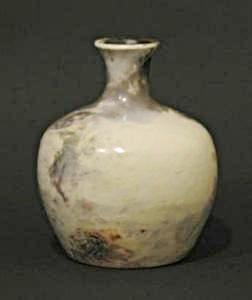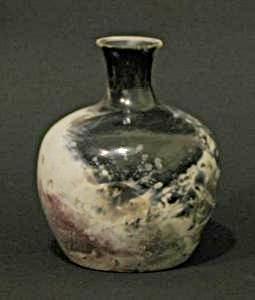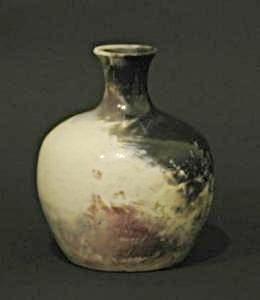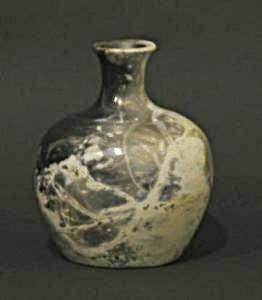I promised to write about this pot, so here it is. First some technical details: the piece stands 4.5 inches (11.4 cm) tall; the clay body was a commercial porcelaneous white stoneware clay (OH6) from Clay Art Center of Tacoma, WA. It was thrown on the wheel in one piece and burnished with a smooth pebble just after the leather hard stage. A white terra sigillata was applied, and the pot further burnished — now with a piece of lightweight clear plastic wrapped around my index finger — just right before it turned bone dry. It was then bisqued to cone 06 in an electric kiln. After the bisque it sat on my shelves for months until last Thanksgiving, when I pit fired it at my brother’s place out in the country. The process of the pit firing (in a BBQ smoker using wood and horse dung as fuel) was described in detail in a previous post so here I’ll just show some photos of the firing results.

Many of my pit fired pieces have one side that’s more quiet, with less fire marks and fuming actions. The quiet side can have its own charm, though. Here in the “back” side of this piece (figure 1) we can see some beautiful, subtle grays (from the horse dung perhaps) on the neck, and then a range of orange and yellow-ish blushes near the bottom — probably caused by the salt from the salted raffia that I used to wrap the pot with (see my previous post for the “before” — as in “before vs. after” — pictures.)

During the firing, the piece was planted upside down at a 60-degree angle into a bed of horse dung. As can be seen in the photo above (figure 2), the part of the neck and shoulder of the piece that was buried in the dung shows a rich, deep, shiny black.

Even though I did not put a lot of copper carbonate into this pit, luckily for me some of the charateristic deep maroon red flashes from this copper compound managed to find their way onto this pot (figure 3).

While the raffia is often used as a conduit to bring salt close to the surface of the pot for fuming (i.e. to get the orange, yellow, peach blushes you see in figure 1, for example), it can also — under the right circumstances — work as a resist mask to leave an interesting pattern on the surface of the pot (figure 4).